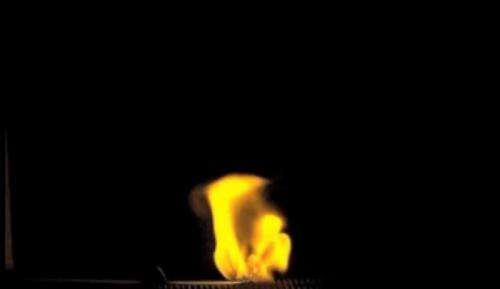February 10, 2015 report
Study offers hint at a way to predict 'blow up' fires

(Phys.org)—A pair of researchers with Harvard University has found that a simple experiment they conducted in their lab might lead to helping predict when fires in buildings or forests might be on the verge of becoming "blow up" fires. In their paper published in Proceedings of the National Academy of Sciences, Jerome Fox and George Whitesides describe their experiment and why they believe what they have learned might help firefighters at some point in the future.
All firefighters are familiar with the term "blow up" fire—it is when a fire suddenly grows in magnitude and intensity creating a very dangerous situation. Unfortunately, there is no way to predict when a blow up is likely to occur, thus those attempting to put out such fires are usually surprised when it occurs. In this new effort, the research pair thought that the behavior of blow up fires showed similarities to phase transitions in other instances and devised a simple experiment to see if they could confirm their suspicions.
In the lab, the researchers placed nitrocellulose strips on a wire mesh grid (a piece of window screen) and filmed what occurred when they lit one end of the strip. The strips burn, like a fuse, from one end to the other, and if left alone, generally do so in a slow orderly fashion. But, in the lab, the researchers found that they could cause a blow up by changing the conditions under which the strip was burned, by altering the slope, for example, adding wind, or by introducing a bump by bending the strip prior to lighting. By fine tuning the alterations, they were able to nudge the fire ever closer to a blow up which allowed them to confirm that the blow ups conformed to what is known as "critical slowing down"—where the closer a system is to collapse, the more time it takes to recover from an event.
The research pair acknowledge that real world fires, whether in buildings or forests are far more complex with many more variables at play, but believe what they have found likely has enough in common with real fires to warrant further research—which could lead to offering firefighters a way to better predict when a fire is suddenly going to change.
More information: Warning signals for eruptive events in spreading fires, Jerome M. Fox, PNAS, DOI: 10.1073/pnas.1417043112
Abstract
Spreading fires are noisy (and potentially chaotic) systems in which transitions in dynamics are notoriously difficult to predict. As flames move through spatially heterogeneous environments, sudden shifts in temperature, wind, or topography can generate combustion instabilities, or trigger self-stabilizing feedback loops, that dramatically amplify the intensities and rates with which fires propagate. Such transitions are rarely captured by predictive models of fire behavior and, thus, complicate efforts in fire suppression. This paper describes a simple, remarkably instructive physical model for examining the eruption of small flames into intense, rapidly moving flames stabilized by feedback between wind and fire (i.e., "wind–fire coupling"—a mechanism of feedback particularly relevant to forest fires), and it presents evidence that characteristic patterns in the dynamics of spreading flames indicate when such transitions are likely to occur. In this model system, flames propagate along strips of nitrocellulose with one of two possible modes of propagation: a slow, structured mode, and a fast, unstructured mode sustained by wind–fire coupling. Experimental examination of patterns in dynamics that emerge near bifurcation points suggests that symptoms of critical slowing down (i.e., the slowed recovery of the system from perturbations as it approaches tipping points) warn of impending transitions to the unstructured mode. Findings suggest that slowing responses of spreading flames to sudden changes in environment (e.g., wind, terrain, temperature) may anticipate the onset of intense, feedback-stabilized modes of propagation (e.g., "blowup fires" in forests).
Journal information: Proceedings of the National Academy of Sciences
© 2015 Phys.org



















